



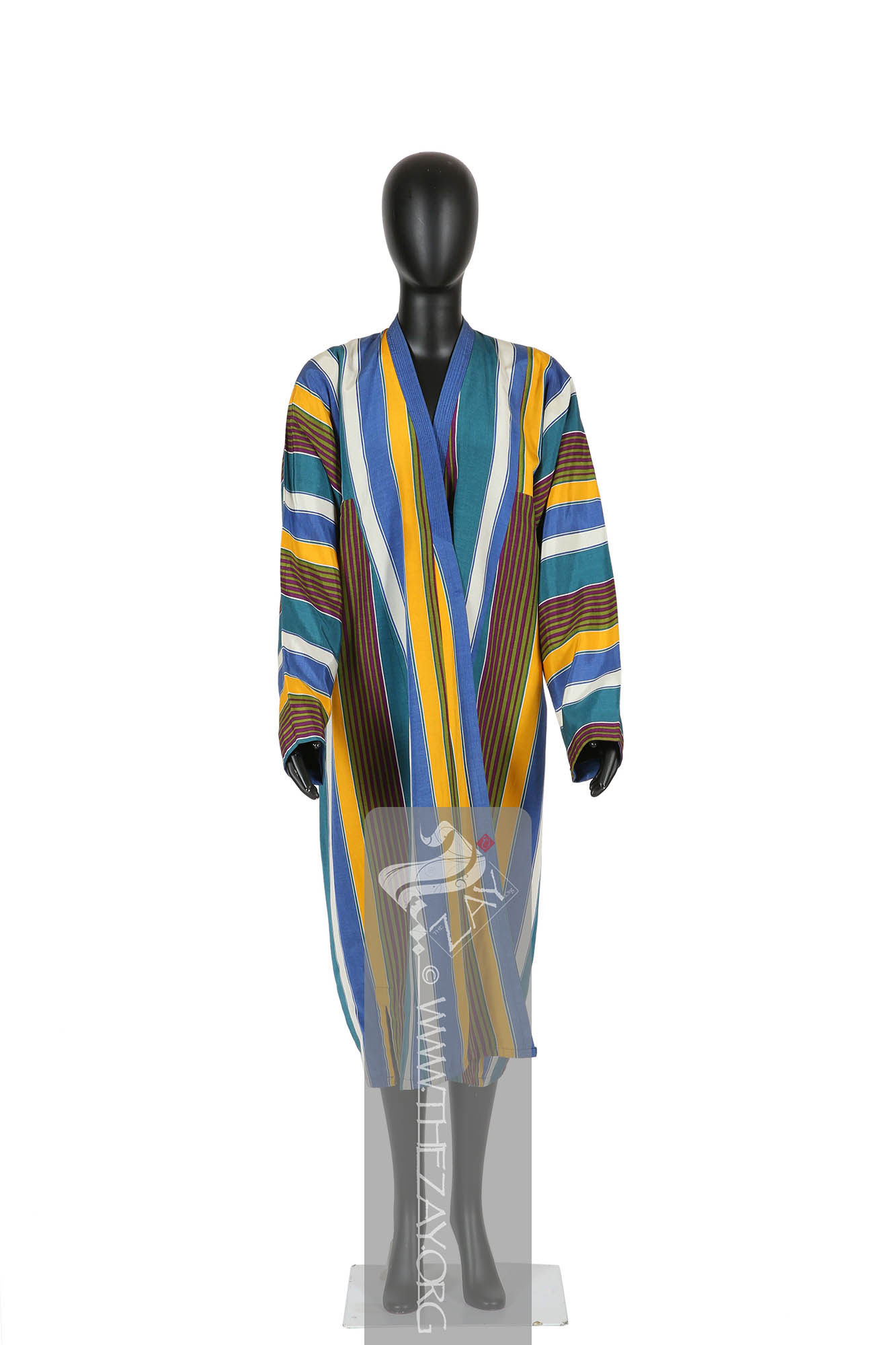
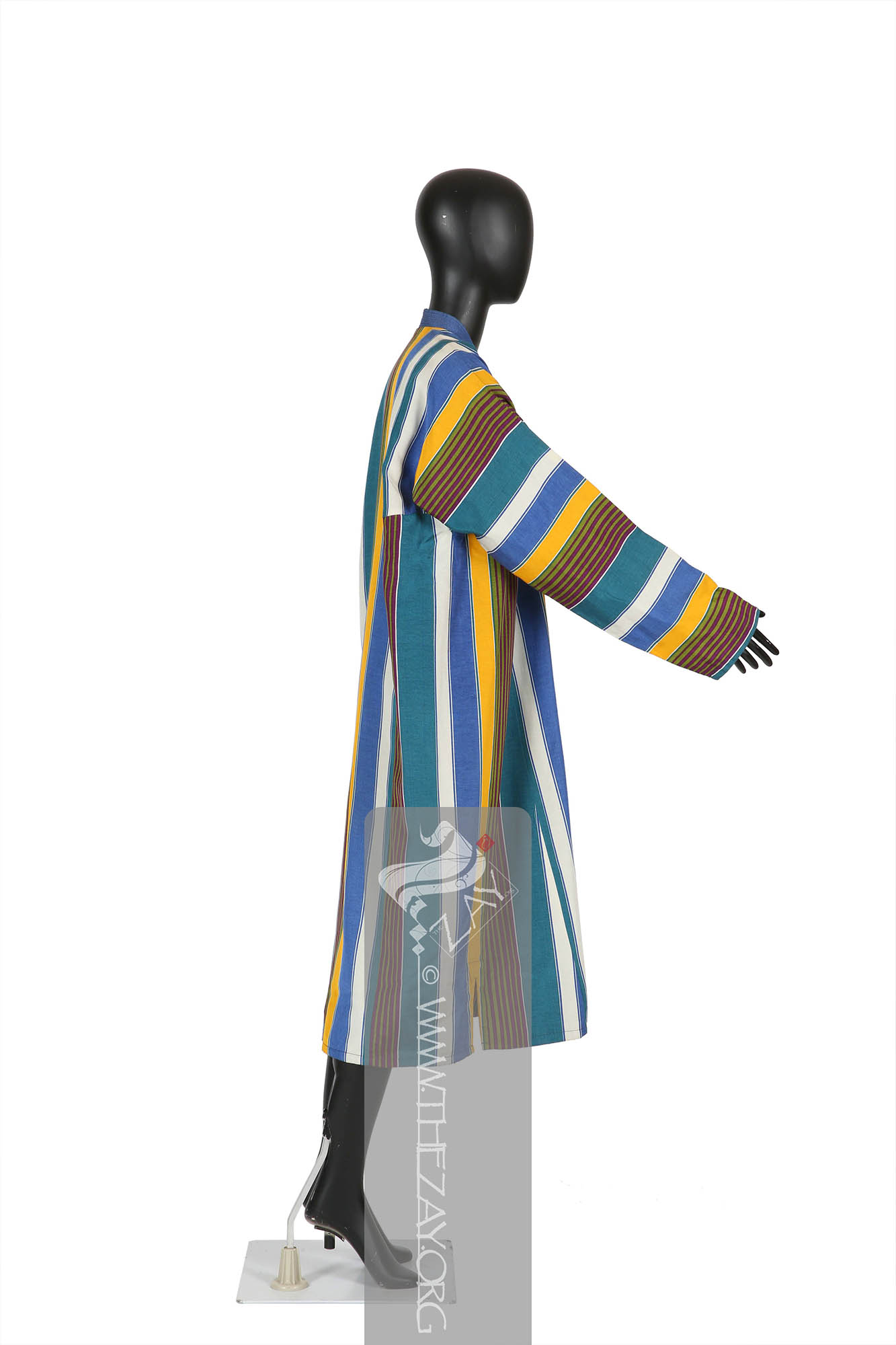
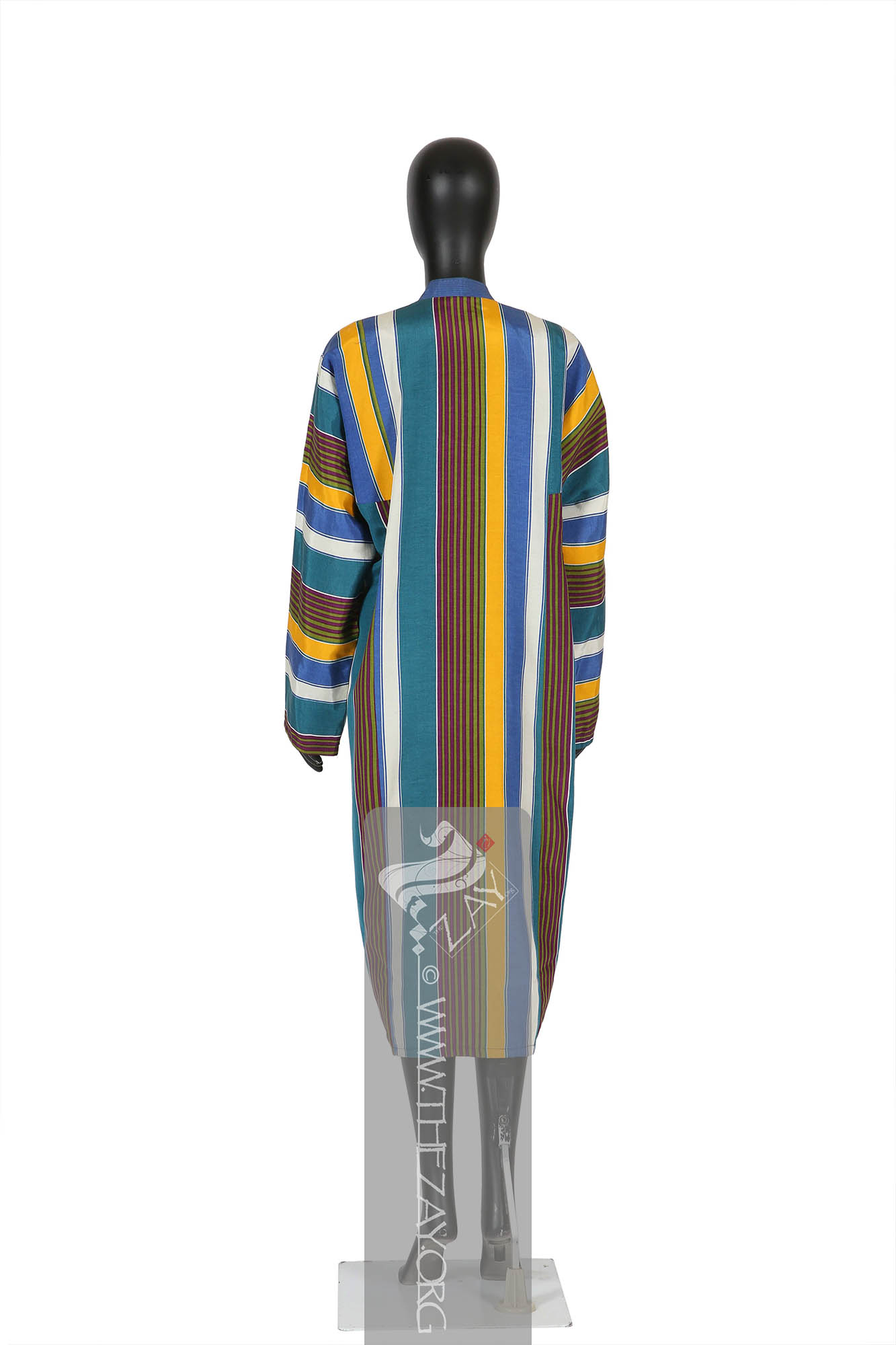
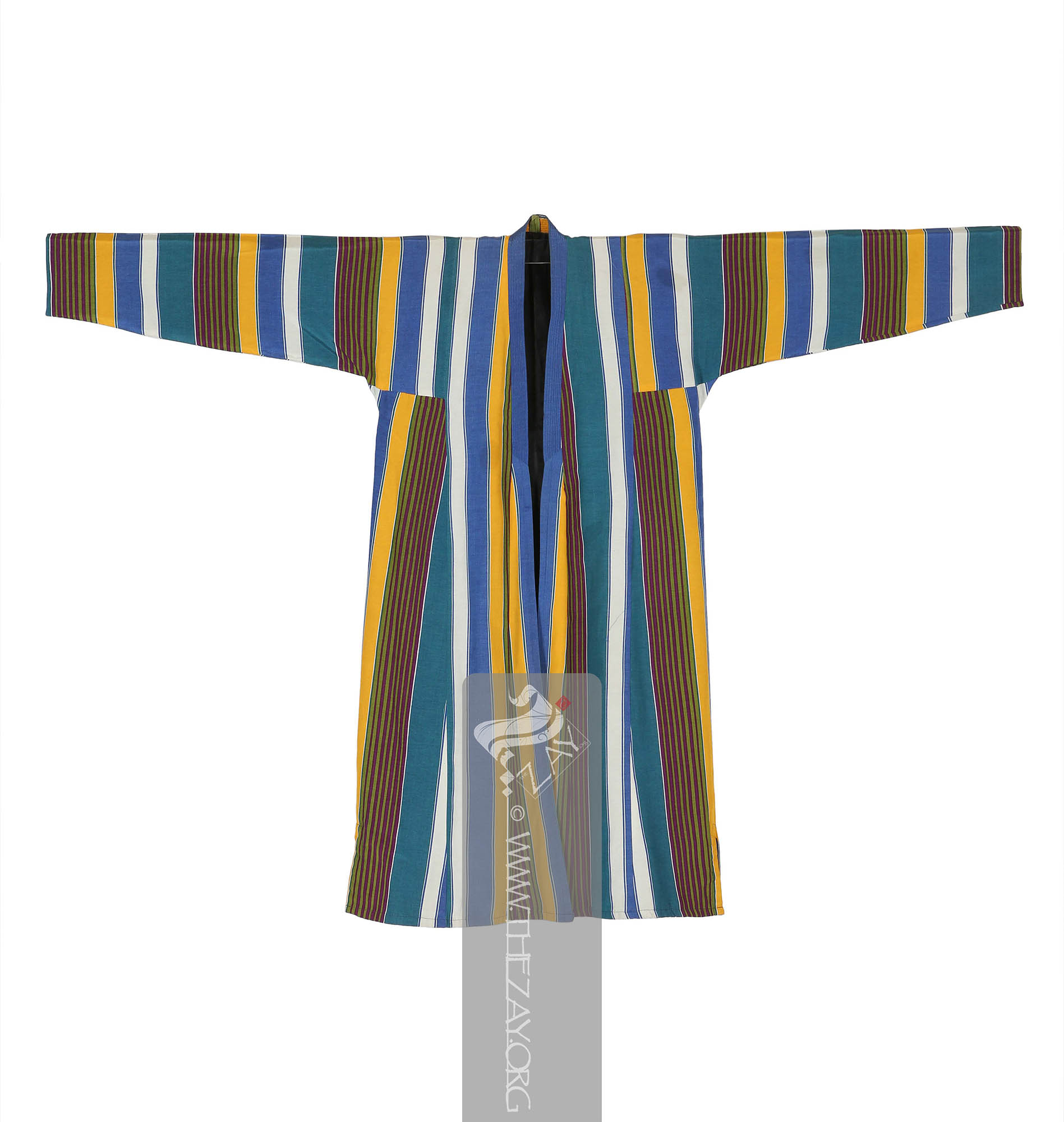
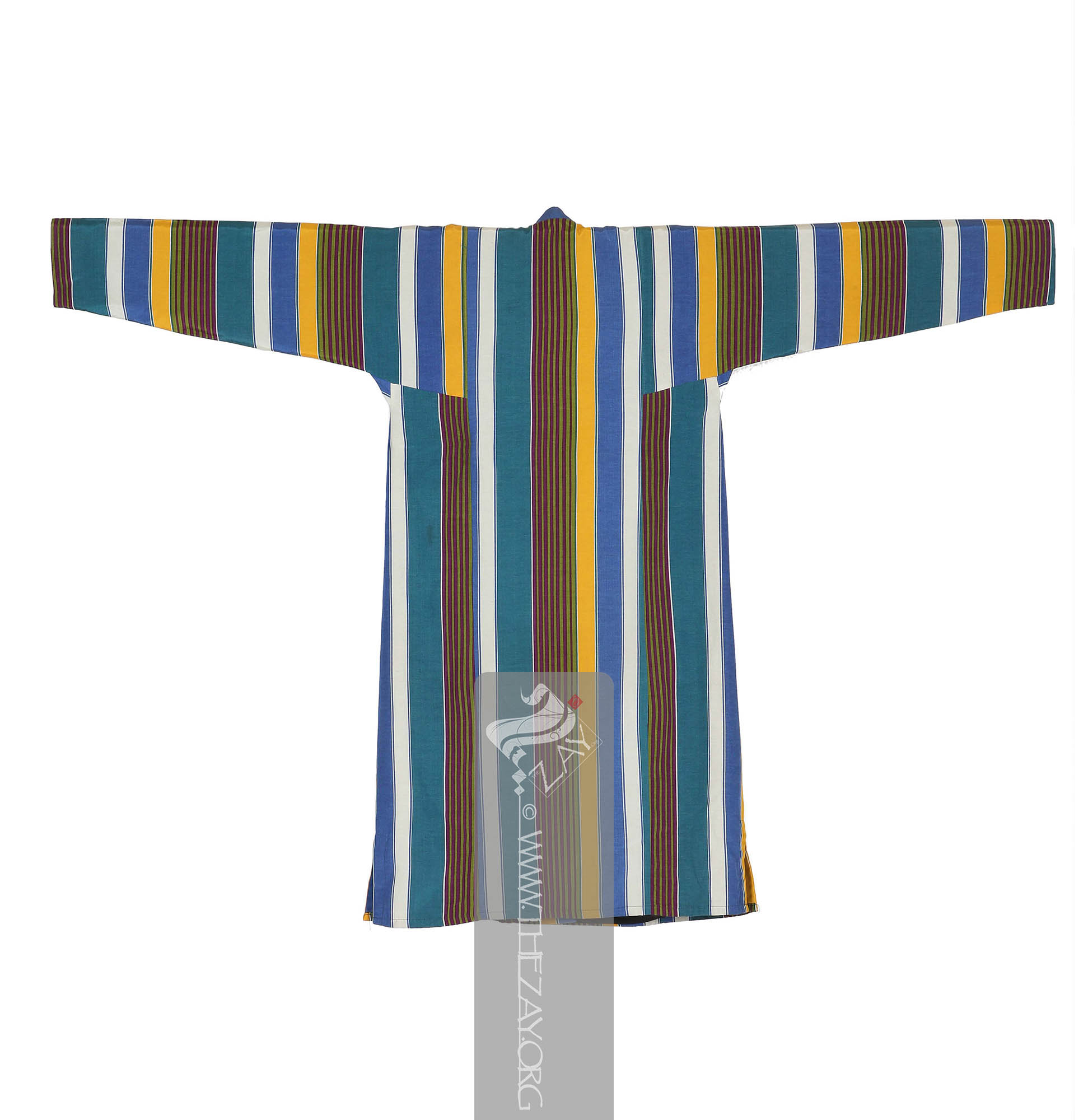
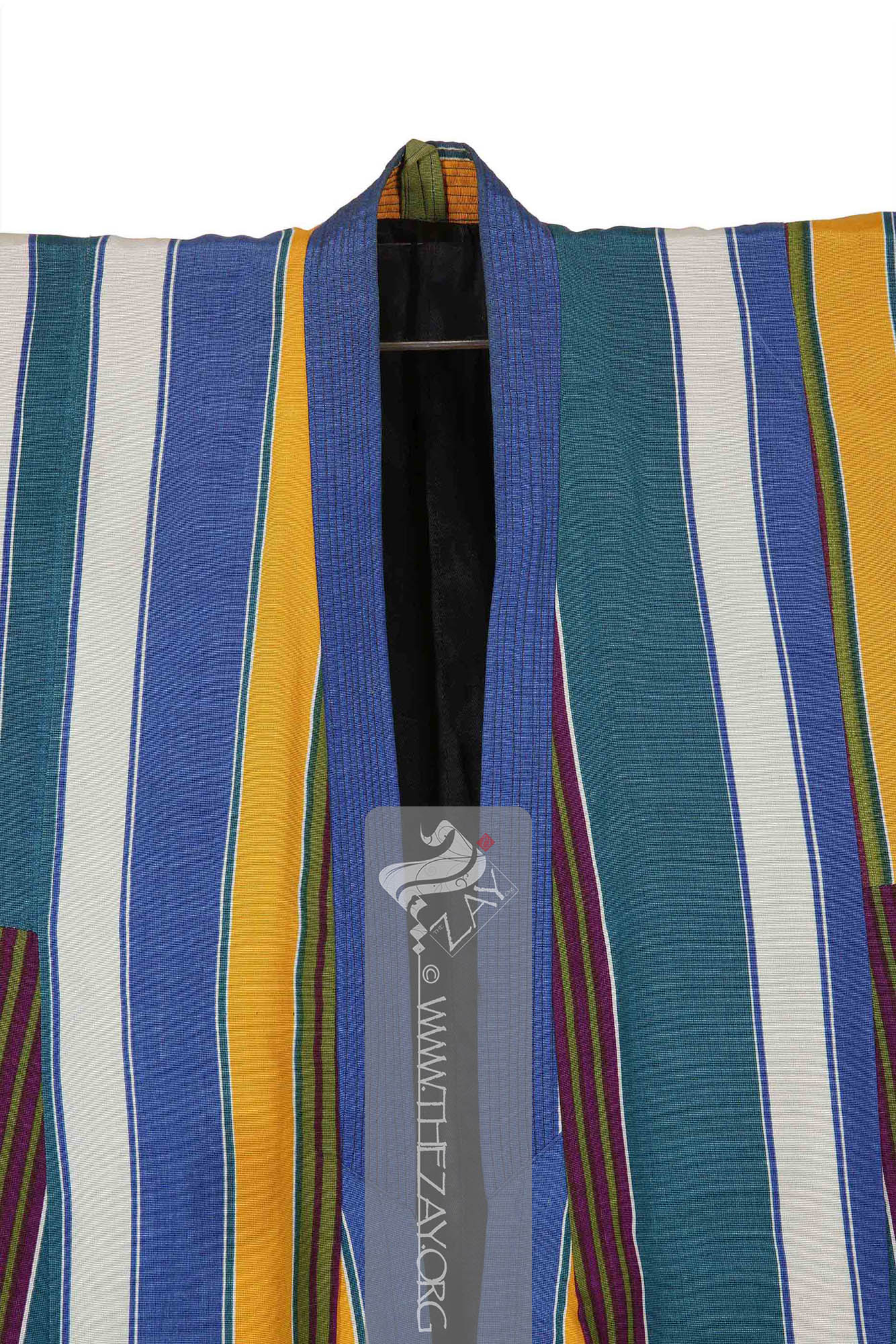

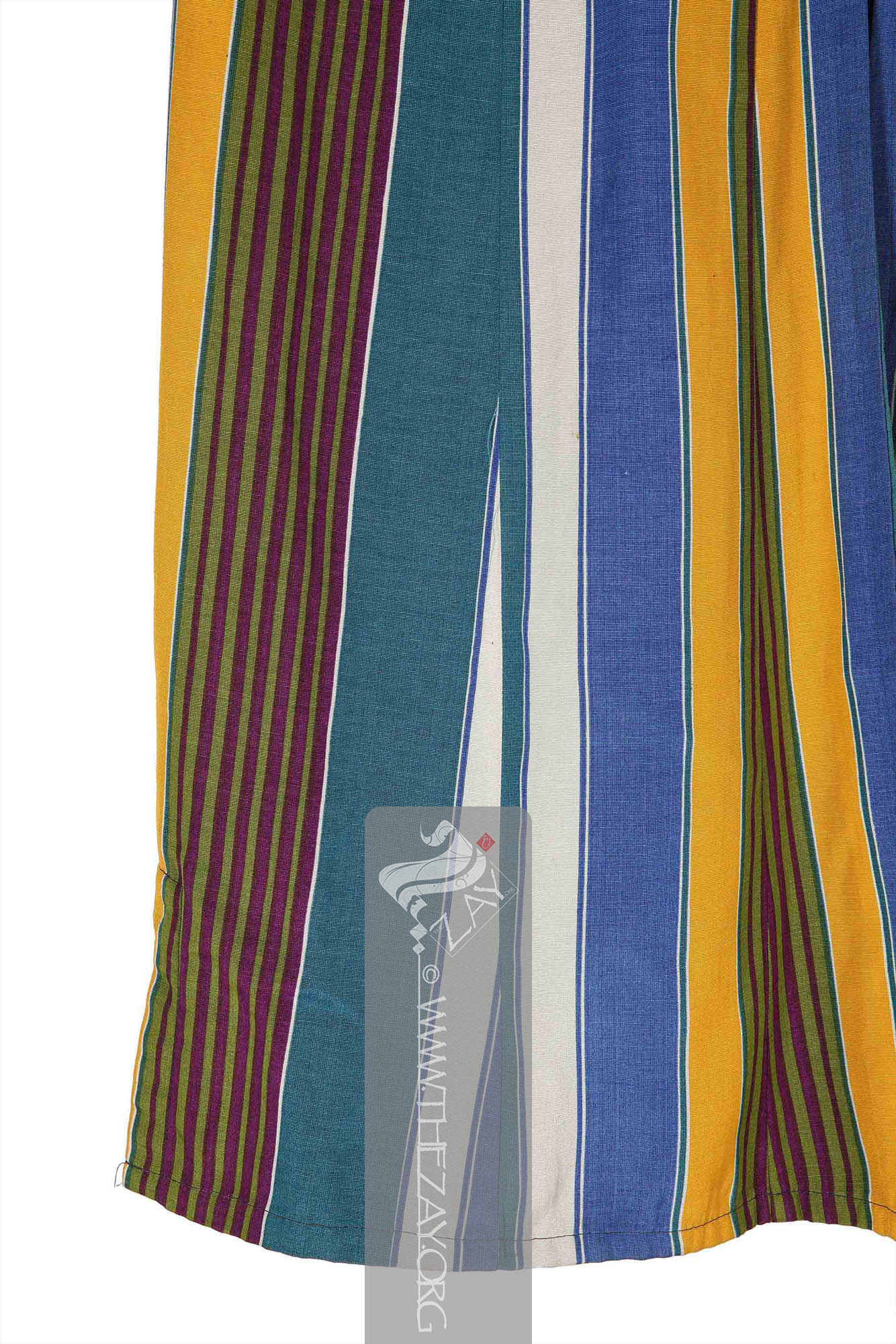

| Local Name | Khalat, Yatak |
| Object Category | Overgarment |
| Gender | Male |
| Place Of orgin | Asia |
| Region | Central Asia |
| Object Range | Uzbekistan, Turkmenistan, Tajikistan, Kazakhstan, Kyrgyzstan, Afghanistan, Iran, India, Pakistan, China, Russia, Turkey, Romania |
| Dimensions | Length: 117 cm Width: 168 cm |
| Materials | Silk Cotton |
| Technique | |
| Motif | Geometric |
| Provenance | Purchased, Blue Souk, Sharjah UAE 1995 |
| Location | The Zay Zay: (Arabic: costume, Pl. azyaā’), a set of clothes in a style typical of a particular country or historical period. Initiative |
| Status | In Storage |
| ZI number | ZI1995.500928 ASIA |
Ṭariq: (Arabic; Synonym: tulle_bi_talli
Tūlle_bi_tallī: (French: Tulle – a city in France where fine material for veil was first made; Turkish: tel – wire; Synonym: tariq; talli; badla; khus_dozi ), series of small metal knots made on a woven net ground as embellishment. The term is commonly used in the North African Arab region specifically in Egypt.
Ṭariq: (Arabic; Synonym: tulle_bi_talli
Tūlle_bi_tallī: (French: Tulle – a city in France where fine material for veil was first made; Turkish: tel – wire; Synonym: tariq; talli; badla; khus_dozi ), series of small metal knots made on a woven net ground as embellishment. The term is commonly used in the North African Arab region specifically in Egypt.
Aṭlas: (Latin: Atticus Atlas
Atlas: (Arabic and Aramaic: atlas – silk; from Greek: Atlas – Character from Greek mythology Synonym: adras, ikat
Ikat: (Indonesian and Malay: Chord, thread, bundle; Synonym: atlas, adras), is a resist dyeing technique that involves tying and dyeing yarns or threads before weaving, resulting in a distinct pattern. With strong traditions in Southeast Asia, Central Asia, the Indian subcontinent and Central America it probably originated independently around the world. , abr), a resist dyeing technique that involves tying and dyeing yarns or threads before weaving, resulting in a distinct pattern. With strong traditions sporadically across the globe it probably originated independently around the world. – a large silk producing moth; from Greek: Atlas
Atlas: (Arabic and Aramaic: atlas – silk; from Greek: Atlas – Character from Greek mythology Synonym: adras, ikat
Ikat: (Indonesian and Malay: Chord, thread, bundle; Synonym: atlas, adras), is a resist dyeing technique that involves tying and dyeing yarns or threads before weaving, resulting in a distinct pattern. With strong traditions in Southeast Asia, Central Asia, the Indian subcontinent and Central America it probably originated independently around the world. , abr), a resist dyeing technique that involves tying and dyeing yarns or threads before weaving, resulting in a distinct pattern. With strong traditions sporadically across the globe it probably originated independently around the world. – character from Greek mythology; Synonym: harir
Ḥarīr: (Arabic, Synonym: aṭlas), a common term for silk in the Arab world especially the Levant.
Aṭlas: (Latin: Atticus Atlas
Atlas: (Arabic and Aramaic: atlas – silk; from Greek: Atlas – Character from Greek mythology Synonym: adras, ikat
Ikat: (Indonesian and Malay: Chord, thread, bundle; Synonym: atlas, adras), is a resist dyeing technique that involves tying and dyeing yarns or threads before weaving, resulting in a distinct pattern. With strong traditions in Southeast Asia, Central Asia, the Indian subcontinent and Central America it probably originated independently around the world. , abr), a resist dyeing technique that involves tying and dyeing yarns or threads before weaving, resulting in a distinct pattern. With strong traditions sporadically across the globe it probably originated independently around the world. – a large silk producing moth; from Greek: Atlas
Atlas: (Arabic and Aramaic: atlas – silk; from Greek: Atlas – Character from Greek mythology Synonym: adras, ikat
Ikat: (Indonesian and Malay: Chord, thread, bundle; Synonym: atlas, adras), is a resist dyeing technique that involves tying and dyeing yarns or threads before weaving, resulting in a distinct pattern. With strong traditions in Southeast Asia, Central Asia, the Indian subcontinent and Central America it probably originated independently around the world. , abr), a resist dyeing technique that involves tying and dyeing yarns or threads before weaving, resulting in a distinct pattern. With strong traditions sporadically across the globe it probably originated independently around the world. – character from Greek mythology; Synonym: harir
Ḥarīr: (Arabic, Synonym: aṭlas), a common term for silk in the Arab world especially the Levant.
Aṭlas: (Latin: Atticus Atlas
Atlas: (Arabic and Aramaic: atlas – silk; from Greek: Atlas – Character from Greek mythology Synonym: adras, ikat
Ikat: (Indonesian and Malay: Chord, thread, bundle; Synonym: atlas, adras), is a resist dyeing technique that involves tying and dyeing yarns or threads before weaving, resulting in a distinct pattern. With strong traditions in Southeast Asia, Central Asia, the Indian subcontinent and Central America it probably originated independently around the world. , abr), a resist dyeing technique that involves tying and dyeing yarns or threads before weaving, resulting in a distinct pattern. With strong traditions sporadically across the globe it probably originated independently around the world. – a large silk producing moth; from Greek: Atlas
Atlas: (Arabic and Aramaic: atlas – silk; from Greek: Atlas – Character from Greek mythology Synonym: adras, ikat
Ikat: (Indonesian and Malay: Chord, thread, bundle; Synonym: atlas, adras), is a resist dyeing technique that involves tying and dyeing yarns or threads before weaving, resulting in a distinct pattern. With strong traditions in Southeast Asia, Central Asia, the Indian subcontinent and Central America it probably originated independently around the world. , abr), a resist dyeing technique that involves tying and dyeing yarns or threads before weaving, resulting in a distinct pattern. With strong traditions sporadically across the globe it probably originated independently around the world. – character from Greek mythology; Synonym: harir
Ḥarīr: (Arabic, Synonym: aṭlas), a common term for silk in the Arab world especially the Levant.
Aṭlas: (Latin: Atticus Atlas
Atlas: (Arabic and Aramaic: atlas – silk; from Greek: Atlas – Character from Greek mythology Synonym: adras, ikat
Ikat: (Indonesian and Malay: Chord, thread, bundle; Synonym: atlas, adras), is a resist dyeing technique that involves tying and dyeing yarns or threads before weaving, resulting in a distinct pattern. With strong traditions in Southeast Asia, Central Asia, the Indian subcontinent and Central America it probably originated independently around the world. , abr), a resist dyeing technique that involves tying and dyeing yarns or threads before weaving, resulting in a distinct pattern. With strong traditions sporadically across the globe it probably originated independently around the world. – a large silk producing moth; from Greek: Atlas
Atlas: (Arabic and Aramaic: atlas – silk; from Greek: Atlas – Character from Greek mythology Synonym: adras, ikat
Ikat: (Indonesian and Malay: Chord, thread, bundle; Synonym: atlas, adras), is a resist dyeing technique that involves tying and dyeing yarns or threads before weaving, resulting in a distinct pattern. With strong traditions in Southeast Asia, Central Asia, the Indian subcontinent and Central America it probably originated independently around the world. , abr), a resist dyeing technique that involves tying and dyeing yarns or threads before weaving, resulting in a distinct pattern. With strong traditions sporadically across the globe it probably originated independently around the world. – character from Greek mythology; Synonym: harir
Ḥarīr: (Arabic, Synonym: aṭlas), a common term for silk in the Arab world especially the Levant.
Aṭlas: (Latin: Atticus Atlas
Atlas: (Arabic and Aramaic: atlas – silk; from Greek: Atlas – Character from Greek mythology Synonym: adras, ikat
Ikat: (Indonesian and Malay: Chord, thread, bundle; Synonym: atlas, adras), is a resist dyeing technique that involves tying and dyeing yarns or threads before weaving, resulting in a distinct pattern. With strong traditions in Southeast Asia, Central Asia, the Indian subcontinent and Central America it probably originated independently around the world. , abr), a resist dyeing technique that involves tying and dyeing yarns or threads before weaving, resulting in a distinct pattern. With strong traditions sporadically across the globe it probably originated independently around the world. – a large silk producing moth; from Greek: Atlas
Atlas: (Arabic and Aramaic: atlas – silk; from Greek: Atlas – Character from Greek mythology Synonym: adras, ikat
Ikat: (Indonesian and Malay: Chord, thread, bundle; Synonym: atlas, adras), is a resist dyeing technique that involves tying and dyeing yarns or threads before weaving, resulting in a distinct pattern. With strong traditions in Southeast Asia, Central Asia, the Indian subcontinent and Central America it probably originated independently around the world. , abr), a resist dyeing technique that involves tying and dyeing yarns or threads before weaving, resulting in a distinct pattern. With strong traditions sporadically across the globe it probably originated independently around the world. – character from Greek mythology; Synonym: harir
Ḥarīr: (Arabic, Synonym: aṭlas), a common term for silk in the Arab world especially the Levant.
Aṭlas: (Latin: Atticus Atlas
Atlas: (Arabic and Aramaic: atlas – silk; from Greek: Atlas – Character from Greek mythology Synonym: adras, ikat
Ikat: (Indonesian and Malay: Chord, thread, bundle; Synonym: atlas, adras), is a resist dyeing technique that involves tying and dyeing yarns or threads before weaving, resulting in a distinct pattern. With strong traditions in Southeast Asia, Central Asia, the Indian subcontinent and Central America it probably originated independently around the world. , abr), a resist dyeing technique that involves tying and dyeing yarns or threads before weaving, resulting in a distinct pattern. With strong traditions sporadically across the globe it probably originated independently around the world. – a large silk producing moth; from Greek: Atlas
Atlas: (Arabic and Aramaic: atlas – silk; from Greek: Atlas – Character from Greek mythology Synonym: adras, ikat
Ikat: (Indonesian and Malay: Chord, thread, bundle; Synonym: atlas, adras), is a resist dyeing technique that involves tying and dyeing yarns or threads before weaving, resulting in a distinct pattern. With strong traditions in Southeast Asia, Central Asia, the Indian subcontinent and Central America it probably originated independently around the world. , abr), a resist dyeing technique that involves tying and dyeing yarns or threads before weaving, resulting in a distinct pattern. With strong traditions sporadically across the globe it probably originated independently around the world. – character from Greek mythology; Synonym: harir
Ḥarīr: (Arabic, Synonym: aṭlas), a common term for silk in the Arab world especially the Levant.
Aṭlas: (Latin: Atticus Atlas
Atlas: (Arabic and Aramaic: atlas – silk; from Greek: Atlas – Character from Greek mythology Synonym: adras, ikat
Ikat: (Indonesian and Malay: Chord, thread, bundle; Synonym: atlas, adras), is a resist dyeing technique that involves tying and dyeing yarns or threads before weaving, resulting in a distinct pattern. With strong traditions in Southeast Asia, Central Asia, the Indian subcontinent and Central America it probably originated independently around the world. , abr), a resist dyeing technique that involves tying and dyeing yarns or threads before weaving, resulting in a distinct pattern. With strong traditions sporadically across the globe it probably originated independently around the world. – a large silk producing moth; from Greek: Atlas
Atlas: (Arabic and Aramaic: atlas – silk; from Greek: Atlas – Character from Greek mythology Synonym: adras, ikat
Ikat: (Indonesian and Malay: Chord, thread, bundle; Synonym: atlas, adras), is a resist dyeing technique that involves tying and dyeing yarns or threads before weaving, resulting in a distinct pattern. With strong traditions in Southeast Asia, Central Asia, the Indian subcontinent and Central America it probably originated independently around the world. , abr), a resist dyeing technique that involves tying and dyeing yarns or threads before weaving, resulting in a distinct pattern. With strong traditions sporadically across the globe it probably originated independently around the world. – character from Greek mythology; Synonym: harir
Ḥarīr: (Arabic, Synonym: aṭlas), a common term for silk in the Arab world especially the Levant.
Aṭlas: (Latin: Atticus Atlas
Atlas: (Arabic and Aramaic: atlas – silk; from Greek: Atlas – Character from Greek mythology Synonym: adras, ikat
Ikat: (Indonesian and Malay: Chord, thread, bundle; Synonym: atlas, adras), is a resist dyeing technique that involves tying and dyeing yarns or threads before weaving, resulting in a distinct pattern. With strong traditions in Southeast Asia, Central Asia, the Indian subcontinent and Central America it probably originated independently around the world. , abr), a resist dyeing technique that involves tying and dyeing yarns or threads before weaving, resulting in a distinct pattern. With strong traditions sporadically across the globe it probably originated independently around the world. – a large silk producing moth; from Greek: Atlas
Atlas: (Arabic and Aramaic: atlas – silk; from Greek: Atlas – Character from Greek mythology Synonym: adras, ikat
Ikat: (Indonesian and Malay: Chord, thread, bundle; Synonym: atlas, adras), is a resist dyeing technique that involves tying and dyeing yarns or threads before weaving, resulting in a distinct pattern. With strong traditions in Southeast Asia, Central Asia, the Indian subcontinent and Central America it probably originated independently around the world. , abr), a resist dyeing technique that involves tying and dyeing yarns or threads before weaving, resulting in a distinct pattern. With strong traditions sporadically across the globe it probably originated independently around the world. – character from Greek mythology; Synonym: harir
Ḥarīr: (Arabic, Synonym: aṭlas), a common term for silk in the Arab world especially the Levant.
Aṭlas: (Latin: Atticus Atlas
Atlas: (Arabic and Aramaic: atlas – silk; from Greek: Atlas – Character from Greek mythology Synonym: adras, ikat
Ikat: (Indonesian and Malay: Chord, thread, bundle; Synonym: atlas, adras), is a resist dyeing technique that involves tying and dyeing yarns or threads before weaving, resulting in a distinct pattern. With strong traditions in Southeast Asia, Central Asia, the Indian subcontinent and Central America it probably originated independently around the world. , abr), a resist dyeing technique that involves tying and dyeing yarns or threads before weaving, resulting in a distinct pattern. With strong traditions sporadically across the globe it probably originated independently around the world. – a large silk producing moth; from Greek: Atlas
Atlas: (Arabic and Aramaic: atlas – silk; from Greek: Atlas – Character from Greek mythology Synonym: adras, ikat
Ikat: (Indonesian and Malay: Chord, thread, bundle; Synonym: atlas, adras), is a resist dyeing technique that involves tying and dyeing yarns or threads before weaving, resulting in a distinct pattern. With strong traditions in Southeast Asia, Central Asia, the Indian subcontinent and Central America it probably originated independently around the world. , abr), a resist dyeing technique that involves tying and dyeing yarns or threads before weaving, resulting in a distinct pattern. With strong traditions sporadically across the globe it probably originated independently around the world. – character from Greek mythology; Synonym: harir
Ḥarīr: (Arabic, Synonym: aṭlas), a common term for silk in the Arab world especially the Levant.
Aṭlas: (Latin: Atticus Atlas
Atlas: (Arabic and Aramaic: atlas – silk; from Greek: Atlas – Character from Greek mythology Synonym: adras, ikat
Ikat: (Indonesian and Malay: Chord, thread, bundle; Synonym: atlas, adras), is a resist dyeing technique that involves tying and dyeing yarns or threads before weaving, resulting in a distinct pattern. With strong traditions in Southeast Asia, Central Asia, the Indian subcontinent and Central America it probably originated independently around the world. , abr), a resist dyeing technique that involves tying and dyeing yarns or threads before weaving, resulting in a distinct pattern. With strong traditions sporadically across the globe it probably originated independently around the world. – a large silk producing moth; from Greek: Atlas
Atlas: (Arabic and Aramaic: atlas – silk; from Greek: Atlas – Character from Greek mythology Synonym: adras, ikat
Ikat: (Indonesian and Malay: Chord, thread, bundle; Synonym: atlas, adras), is a resist dyeing technique that involves tying and dyeing yarns or threads before weaving, resulting in a distinct pattern. With strong traditions in Southeast Asia, Central Asia, the Indian subcontinent and Central America it probably originated independently around the world. , abr), a resist dyeing technique that involves tying and dyeing yarns or threads before weaving, resulting in a distinct pattern. With strong traditions sporadically across the globe it probably originated independently around the world. – character from Greek mythology; Synonym: harir
Ḥarīr: (Arabic, Synonym: aṭlas), a common term for silk in the Arab world especially the Levant.
Aṭlas: (Latin: Atticus Atlas
Atlas: (Arabic and Aramaic: atlas – silk; from Greek: Atlas – Character from Greek mythology Synonym: adras, ikat
Ikat: (Indonesian and Malay: Chord, thread, bundle; Synonym: atlas, adras), is a resist dyeing technique that involves tying and dyeing yarns or threads before weaving, resulting in a distinct pattern. With strong traditions in Southeast Asia, Central Asia, the Indian subcontinent and Central America it probably originated independently around the world. , abr), a resist dyeing technique that involves tying and dyeing yarns or threads before weaving, resulting in a distinct pattern. With strong traditions sporadically across the globe it probably originated independently around the world. – a large silk producing moth; from Greek: Atlas
Atlas: (Arabic and Aramaic: atlas – silk; from Greek: Atlas – Character from Greek mythology Synonym: adras, ikat
Ikat: (Indonesian and Malay: Chord, thread, bundle; Synonym: atlas, adras), is a resist dyeing technique that involves tying and dyeing yarns or threads before weaving, resulting in a distinct pattern. With strong traditions in Southeast Asia, Central Asia, the Indian subcontinent and Central America it probably originated independently around the world. , abr), a resist dyeing technique that involves tying and dyeing yarns or threads before weaving, resulting in a distinct pattern. With strong traditions sporadically across the globe it probably originated independently around the world. – character from Greek mythology; Synonym: harir
Ḥarīr: (Arabic, Synonym: aṭlas), a common term for silk in the Arab world especially the Levant.
Aṭlas: (Latin: Atticus Atlas
Atlas: (Arabic and Aramaic: atlas – silk; from Greek: Atlas – Character from Greek mythology Synonym: adras, ikat
Ikat: (Indonesian and Malay: Chord, thread, bundle; Synonym: atlas, adras), is a resist dyeing technique that involves tying and dyeing yarns or threads before weaving, resulting in a distinct pattern. With strong traditions in Southeast Asia, Central Asia, the Indian subcontinent and Central America it probably originated independently around the world. , abr), a resist dyeing technique that involves tying and dyeing yarns or threads before weaving, resulting in a distinct pattern. With strong traditions sporadically across the globe it probably originated independently around the world. – a large silk producing moth; from Greek: Atlas
Atlas: (Arabic and Aramaic: atlas – silk; from Greek: Atlas – Character from Greek mythology Synonym: adras, ikat
Ikat: (Indonesian and Malay: Chord, thread, bundle; Synonym: atlas, adras), is a resist dyeing technique that involves tying and dyeing yarns or threads before weaving, resulting in a distinct pattern. With strong traditions in Southeast Asia, Central Asia, the Indian subcontinent and Central America it probably originated independently around the world. , abr), a resist dyeing technique that involves tying and dyeing yarns or threads before weaving, resulting in a distinct pattern. With strong traditions sporadically across the globe it probably originated independently around the world. – character from Greek mythology; Synonym: harir
Ḥarīr: (Arabic, Synonym: aṭlas), a common term for silk in the Arab world especially the Levant.
Aṭlas: (Latin: Atticus Atlas
Atlas: (Arabic and Aramaic: atlas – silk; from Greek: Atlas – Character from Greek mythology Synonym: adras, ikat
Ikat: (Indonesian and Malay: Chord, thread, bundle; Synonym: atlas, adras), is a resist dyeing technique that involves tying and dyeing yarns or threads before weaving, resulting in a distinct pattern. With strong traditions in Southeast Asia, Central Asia, the Indian subcontinent and Central America it probably originated independently around the world. , abr), a resist dyeing technique that involves tying and dyeing yarns or threads before weaving, resulting in a distinct pattern. With strong traditions sporadically across the globe it probably originated independently around the world. – a large silk producing moth; from Greek: Atlas
Atlas: (Arabic and Aramaic: atlas – silk; from Greek: Atlas – Character from Greek mythology Synonym: adras, ikat
Ikat: (Indonesian and Malay: Chord, thread, bundle; Synonym: atlas, adras), is a resist dyeing technique that involves tying and dyeing yarns or threads before weaving, resulting in a distinct pattern. With strong traditions in Southeast Asia, Central Asia, the Indian subcontinent and Central America it probably originated independently around the world. , abr), a resist dyeing technique that involves tying and dyeing yarns or threads before weaving, resulting in a distinct pattern. With strong traditions sporadically across the globe it probably originated independently around the world. – character from Greek mythology; Synonym: harir
Ḥarīr: (Arabic, Synonym: aṭlas), a common term for silk in the Arab world especially the Levant.
Aṭlas: (Latin: Atticus Atlas
Atlas: (Arabic and Aramaic: atlas – silk; from Greek: Atlas – Character from Greek mythology Synonym: adras, ikat
Ikat: (Indonesian and Malay: Chord, thread, bundle; Synonym: atlas, adras), is a resist dyeing technique that involves tying and dyeing yarns or threads before weaving, resulting in a distinct pattern. With strong traditions in Southeast Asia, Central Asia, the Indian subcontinent and Central America it probably originated independently around the world. , abr), a resist dyeing technique that involves tying and dyeing yarns or threads before weaving, resulting in a distinct pattern. With strong traditions sporadically across the globe it probably originated independently around the world. – a large silk producing moth; from Greek: Atlas
Atlas: (Arabic and Aramaic: atlas – silk; from Greek: Atlas – Character from Greek mythology Synonym: adras, ikat
Ikat: (Indonesian and Malay: Chord, thread, bundle; Synonym: atlas, adras), is a resist dyeing technique that involves tying and dyeing yarns or threads before weaving, resulting in a distinct pattern. With strong traditions in Southeast Asia, Central Asia, the Indian subcontinent and Central America it probably originated independently around the world. , abr), a resist dyeing technique that involves tying and dyeing yarns or threads before weaving, resulting in a distinct pattern. With strong traditions sporadically across the globe it probably originated independently around the world. – character from Greek mythology; Synonym: harir
Ḥarīr: (Arabic, Synonym: aṭlas), a common term for silk in the Arab world especially the Levant.
Aṭlas: (Latin: Atticus Atlas
Atlas: (Arabic and Aramaic: atlas – silk; from Greek: Atlas – Character from Greek mythology Synonym: adras, ikat
Ikat: (Indonesian and Malay: Chord, thread, bundle; Synonym: atlas, adras), is a resist dyeing technique that involves tying and dyeing yarns or threads before weaving, resulting in a distinct pattern. With strong traditions in Southeast Asia, Central Asia, the Indian subcontinent and Central America it probably originated independently around the world. , abr), a resist dyeing technique that involves tying and dyeing yarns or threads before weaving, resulting in a distinct pattern. With strong traditions sporadically across the globe it probably originated independently around the world. – a large silk producing moth; from Greek: Atlas
Atlas: (Arabic and Aramaic: atlas – silk; from Greek: Atlas – Character from Greek mythology Synonym: adras, ikat
Ikat: (Indonesian and Malay: Chord, thread, bundle; Synonym: atlas, adras), is a resist dyeing technique that involves tying and dyeing yarns or threads before weaving, resulting in a distinct pattern. With strong traditions in Southeast Asia, Central Asia, the Indian subcontinent and Central America it probably originated independently around the world. , abr), a resist dyeing technique that involves tying and dyeing yarns or threads before weaving, resulting in a distinct pattern. With strong traditions sporadically across the globe it probably originated independently around the world. – character from Greek mythology; Synonym: harir
Ḥarīr: (Arabic, Synonym: aṭlas), a common term for silk in the Arab world especially the Levant.
Aṭlas: (Latin: Atticus Atlas
Atlas: (Arabic and Aramaic: atlas – silk; from Greek: Atlas – Character from Greek mythology Synonym: adras, ikat
Ikat: (Indonesian and Malay: Chord, thread, bundle; Synonym: atlas, adras), is a resist dyeing technique that involves tying and dyeing yarns or threads before weaving, resulting in a distinct pattern. With strong traditions in Southeast Asia, Central Asia, the Indian subcontinent and Central America it probably originated independently around the world. , abr), a resist dyeing technique that involves tying and dyeing yarns or threads before weaving, resulting in a distinct pattern. With strong traditions sporadically across the globe it probably originated independently around the world. – a large silk producing moth; from Greek: Atlas
Atlas: (Arabic and Aramaic: atlas – silk; from Greek: Atlas – Character from Greek mythology Synonym: adras, ikat
Ikat: (Indonesian and Malay: Chord, thread, bundle; Synonym: atlas, adras), is a resist dyeing technique that involves tying and dyeing yarns or threads before weaving, resulting in a distinct pattern. With strong traditions in Southeast Asia, Central Asia, the Indian subcontinent and Central America it probably originated independently around the world. , abr), a resist dyeing technique that involves tying and dyeing yarns or threads before weaving, resulting in a distinct pattern. With strong traditions sporadically across the globe it probably originated independently around the world. – character from Greek mythology; Synonym: harir
Ḥarīr: (Arabic, Synonym: aṭlas), a common term for silk in the Arab world especially the Levant.
Aṭlas: (Latin: Atticus Atlas
Atlas: (Arabic and Aramaic: atlas – silk; from Greek: Atlas – Character from Greek mythology Synonym: adras, ikat
Ikat: (Indonesian and Malay: Chord, thread, bundle; Synonym: atlas, adras), is a resist dyeing technique that involves tying and dyeing yarns or threads before weaving, resulting in a distinct pattern. With strong traditions in Southeast Asia, Central Asia, the Indian subcontinent and Central America it probably originated independently around the world. , abr), a resist dyeing technique that involves tying and dyeing yarns or threads before weaving, resulting in a distinct pattern. With strong traditions sporadically across the globe it probably originated independently around the world. – a large silk producing moth; from Greek: Atlas
Atlas: (Arabic and Aramaic: atlas – silk; from Greek: Atlas – Character from Greek mythology Synonym: adras, ikat
Ikat: (Indonesian and Malay: Chord, thread, bundle; Synonym: atlas, adras), is a resist dyeing technique that involves tying and dyeing yarns or threads before weaving, resulting in a distinct pattern. With strong traditions in Southeast Asia, Central Asia, the Indian subcontinent and Central America it probably originated independently around the world. , abr), a resist dyeing technique that involves tying and dyeing yarns or threads before weaving, resulting in a distinct pattern. With strong traditions sporadically across the globe it probably originated independently around the world. – character from Greek mythology; Synonym: harir
Ḥarīr: (Arabic, Synonym: aṭlas), a common term for silk in the Arab world especially the Levant.
Aṭlas: (Latin: Atticus Atlas
Atlas: (Arabic and Aramaic: atlas – silk; from Greek: Atlas – Character from Greek mythology Synonym: adras, ikat
Ikat: (Indonesian and Malay: Chord, thread, bundle; Synonym: atlas, adras), is a resist dyeing technique that involves tying and dyeing yarns or threads before weaving, resulting in a distinct pattern. With strong traditions in Southeast Asia, Central Asia, the Indian subcontinent and Central America it probably originated independently around the world. , abr), a resist dyeing technique that involves tying and dyeing yarns or threads before weaving, resulting in a distinct pattern. With strong traditions sporadically across the globe it probably originated independently around the world. – a large silk producing moth; from Greek: Atlas
Atlas: (Arabic and Aramaic: atlas – silk; from Greek: Atlas – Character from Greek mythology Synonym: adras, ikat
Ikat: (Indonesian and Malay: Chord, thread, bundle; Synonym: atlas, adras), is a resist dyeing technique that involves tying and dyeing yarns or threads before weaving, resulting in a distinct pattern. With strong traditions in Southeast Asia, Central Asia, the Indian subcontinent and Central America it probably originated independently around the world. , abr), a resist dyeing technique that involves tying and dyeing yarns or threads before weaving, resulting in a distinct pattern. With strong traditions sporadically across the globe it probably originated independently around the world. – character from Greek mythology; Synonym: harir
Ḥarīr: (Arabic, Synonym: aṭlas), a common term for silk in the Arab world especially the Levant.
Aṭlas: (Latin: Atticus Atlas
Atlas: (Arabic and Aramaic: atlas – silk; from Greek: Atlas – Character from Greek mythology Synonym: adras, ikat
Ikat: (Indonesian and Malay: Chord, thread, bundle; Synonym: atlas, adras), is a resist dyeing technique that involves tying and dyeing yarns or threads before weaving, resulting in a distinct pattern. With strong traditions in Southeast Asia, Central Asia, the Indian subcontinent and Central America it probably originated independently around the world. , abr), a resist dyeing technique that involves tying and dyeing yarns or threads before weaving, resulting in a distinct pattern. With strong traditions sporadically across the globe it probably originated independently around the world. – a large silk producing moth; from Greek: Atlas
Atlas: (Arabic and Aramaic: atlas – silk; from Greek: Atlas – Character from Greek mythology Synonym: adras, ikat
Ikat: (Indonesian and Malay: Chord, thread, bundle; Synonym: atlas, adras), is a resist dyeing technique that involves tying and dyeing yarns or threads before weaving, resulting in a distinct pattern. With strong traditions in Southeast Asia, Central Asia, the Indian subcontinent and Central America it probably originated independently around the world. , abr), a resist dyeing technique that involves tying and dyeing yarns or threads before weaving, resulting in a distinct pattern. With strong traditions sporadically across the globe it probably originated independently around the world. – character from Greek mythology; Synonym: harir
Ḥarīr: (Arabic, Synonym: aṭlas), a common term for silk in the Arab world especially the Levant.